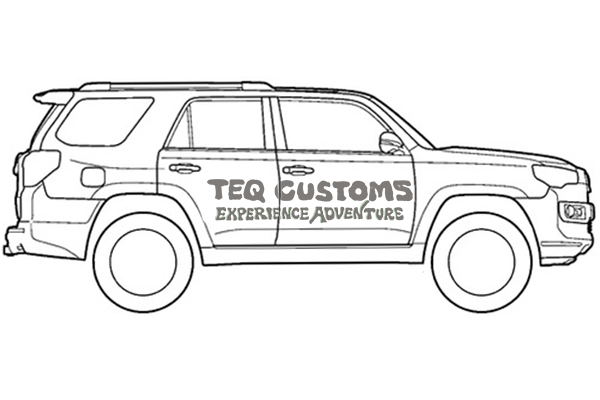A very common question when deciding on your suspension is which spring is going to work best. Ultimately, it depends on the height you want, what extra weight you have, if any, and how you want the vehicle to ride.
Factory Ride Heights
Before you can calculate how much lift you need, it is very important to understand how lift heights are measured and how the factory Toyota suspension sits.
Lift heights from all major manufactures are going to be measured from a new, unmodified 4x4 vehicle unless otherwise noted.
Suspension for trucks will be measured off of a Crew Cab, Short Bed configuration.
Vehicles that had an option for a 4 cylinder or 6 cylinder engine will have the heights measured on the V6 version unless otherwise noted. For newer vehicles with optional hybrid powertrains, any differences in weight will be noted on the lift kit.
**Note: For 4th Gen 4Runners (03-09) that had the optional V8 engine, coils will be noted with a V6 lift height and a V8 lift height.
This information is vital if you have a 4x2, a smaller engine, an access cab or long bed truck, as these will change the weight of the springs you need. In general:
- 4x2 vehicles gain about an inch more lift in the front than a 4x4 would with the same coil spring. If you installed the same spring on both, it will feel stiffer on a 4x2 than a 4x4 due to the lower weight.
- 4 cylinder engines typically gain about an inch more lift in the front verses a 6 Cylinder engine. Again, coils will feel stiffer on a 4cyl vehicle.
- A smaller cab, like an access cab, will not affect the front weight - it will affect the rear. An access cab will gain about .5 of lift more than a double cab.
- A long bed will typically decrease the rear lift height by .5in. Rear leaf springs will also feel softer with a long bed due to the extra weight.
Finally, Toyota Trucks and SUVs come from the factory with suspension rake, which means that the rear sits higher than the front. The purpose of the rake is to allow the suspension room to compress for loading up the rear of the vehicle with cargo or passengers.

The amount of rake varies, but generally;
- Toyota SUVs sit about 1 inch higher in the rear from the factory
- Toyota Trucks sit about 2 inches higher in the rear from the factory
Choosing Your Lift Height
Now, let's talk heights. We'll get to weights in a moment. The mentioned heights are going off of the assumptions mentioned above - measured from an unmodified, 4x4 V6, Double Cab Short Bed truck or an unmodified 4x4 V6 4Runner.
**Note: Older vehicles may have sagging suspension. Do not include that in your lift height calculations. Your springs will be new and un-saggy :)
Leveled

The most common choice is to level the vehicle. Based off what we now know about the stock suspension, to completely level the vehicle we would need to..
- Lift the front of an SUV 1 inch higher than the rear. Ex: 2inch front lift, 1inch rear lift (shown below)

- Lift the front of a truck 2 inches higher than the rear. Ex: 3in front lift, 1in rear lift (shown below)

We highly recommend to leave a little bit of rake in the suspension for adding occasional cargo. To maintain a slight bit of rake, you would want to...
- Lift the front of an SUV .5 inches higher than the rear. Ex: 2.5in front lift, 2in rear (shown below)

- Lift the front of a truck 1 inch higher than the rear. Ex: 3in front lift, 2in rear lift

Maintain Factory Rake

The other common option for lift heights is to maintain the factory rake. This is easily done by matching the front and rear lift heights. An example is shown below.

Choosing the Right Spring Rates
- About 50-70lbs for a LoPro Style front bumper that only replaces the center section of your front bumper
- About 100-150lbs for a full size front bumper (Check your manufactures website for exact weight)
- About 80-100lbs for a winch.
You will typically want a coil for..
- No extra weight with just a LoPro bumper and no winch. It is not enough weight to justify a heavier coil
- About 150 extra lbs for a LoPro bumper and a winch
- About 150 extra lbs of accessory weight for a full front bumper and no winch.
- About 220-250 extra lbs for a full front bumper and winch.
In the rear, most additional weight is going to come from a rear bumper, swingouts, tire carriers, drawer systems, bed racks and tents on trucks, bed camper shells, and any hard mounted gear (for example a Hi-lift jack or jerry cans).
Weights for these items vary quite a bit based on your bumper, any included bumper swingouts, the size of your tire, and your brand of drawer system.
The manufacturers of these items should have weight specs published to get a general number. Don't stress- a general number is completely fine to work with. Your vehicle is not going to ride terribly if you're 50lbs off.
Towing
Unless you will be towing daily, we do not recommend using your springs to compensate for sag when towing. Stiffer coils will kill the ride quality when you are not towing. Helper air bags are a cheap, easy to install way to keep the truck from sagging while towing and not degrade your ride quality.
We hope this article was helpful! If you have any questions about setting up suspension for your vehicle, give us a shout and we'd be happy to help. We have plenty of parts for any application!

